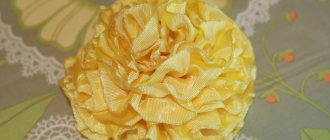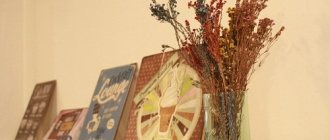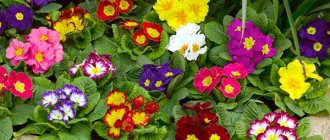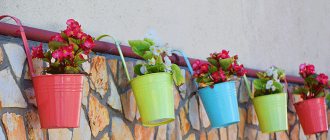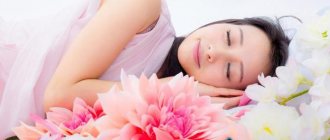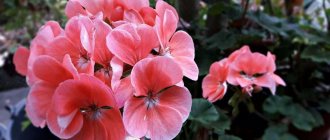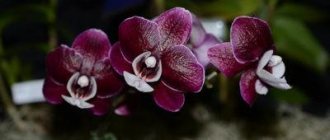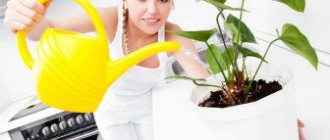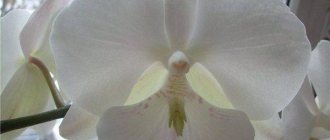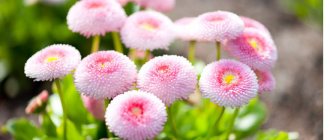- May 19, 2019
- Production
- Svetlana Funtova
Each handmade item is unique. Of the many types of handicrafts, the production of artificial flowers deserves special attention. You will learn from this article what such masterpieces are made of. Artificial flowers are used to decorate a home, any celebration, or simply as a gift to friends and family. Depending on your skill level, you can choose the simplest or more complex technique.
kusudama flower
Kusudama is a technique for making three-dimensional spherical figures, performed according to the origami principle. The easiest kusudama flowers can be made in a matter of minutes. There are a great many manufacturing schemes; it’s better to start with the simplest ones. By gradually modernizing them, it is quite possible to create something unique. How to make artificial flowers with your own hands using this technique? Read on.
Six squares of the same size are cut out of colored or origami paper. Then proceed to step-by-step flower folding for beginners:
- The square is folded in half twice, then unfolded and folded diagonally again. The result should be clearly defined folds; in the future, the following stages of making a kusudama flower will be carried out along these lines.
- The square is turned over so that the corner faces upward, forming a pyramid. The corners of the square are compressed to form a four-pointed three-dimensional star. The corners of the star are twisted alternately onto a toothpick to give the figure an unusual shape. The finished product can be glued together, so it will not lose its shape.
Flowers are attached to a stick wrapped in green paper and collected into a bouquet or glued together many parts, creating a three-dimensional ball using the traditional kusadama technique.
Also, a kusudama flower can be assembled from separately made modules. Follow the diagram shown below in the picture.
Corrugated paper
Due to the plasticity of corrugated paper, it is often used to make various crafts, including flowers. It is easy to create a beautiful bouquet of peonies, tulips, chrysanthemums, daffodils and other flowers from it. This case describes the production of the simplest version of volumetric plants.
How to make artificial flowers using this technology:
- Fold two sheets of corrugated paper in half four times to form a square. Then the square is folded in half diagonally.
- The opposite corner of the resulting triangle is cut off in a semicircle. When expanded, you should get eight circles.
- Each circle is taken in the center and slightly twisted, the base is fixed with tape. When all the parts are twisted, they are glued together until they form a spherical shape.
The finished flowers are placed on a wire or skewer. If you make them more voluminous, you can hang them on ribbons and decorate the room for the celebration.
Basic techniques for making artificial flowers with your own hands
When they start making a flower, the first thing they do is take a wire, wrap it with cotton wool, bend the upper end of the wire into a hook, and then tightly wrap the workpiece with tissue paper or thin silk, which originate inside the loop.
Having secured the strip on the top hook, the wire is quickly rotated with the index and thumb of the left hand, due to which the paper (silk) lies evenly and very tightly. By wrapping leaves or buds around the stem, the excess strips are cut off. They do the same thing when wrapping a stem with cotton wool: the material is straightened, giving it the appearance of a long thread and wound around the stem, cutting off the excess. In specialized literature there may be a professional name for such a stem - liton (or leton in ancient literature). You should remember this rule: if the stem should be thin, then use very little cotton wool - just to cover the wire; if you need to get a thick flexible stem, then you need to take more cotton wool. if you need to make a spherical core or bud, then the cotton wool is tightly wound around the upper end of the wire, bent with a hook, and with your fingers you give the material the required shape. To make the stems of very small flowers - for example, lilac or mignonette, cotton wool is not used at all: the wire is immediately wrapped around paper or silk.
Coloring artificial flowers
Flowers made from cambric or any other paper fabric first need to be moistened. The cut petals are folded 6 or 8 times, after which they are dipped in a saucer of water, squeezed out (without crushing) by hand and laid out to dry on paper that absorbs water well - a filter, blotter, paper towel, etc. A small amount of the desired paint is dripped onto the slightly damp petal, which is then leveled with a finger or a thin brush. If the color needs to be reduced to completely transparent, then a small drop of water is added to this place, which blurs the paint. After these manipulations, stripes, specks and other elements are painted with a brush, bringing the color of the flower closer to natural. After all the blanks have dried, you can start corrugating, pleating or squeezing them with hot/cold bullets - depending on the type of flower. Corrugation
artificial flowers are made either using tweezers or a spherical tool (bulka). An approximate operating algorithm would be as follows:
- the petal is folded in half along the long side;
- put it on the palm of the left hand, and with the right hand, using tweezers, scratch grooves on it from top to bottom;
- after the workpiece is unfolded, identical grooves will be found on it, symmetrically located relative to the center of the petal;
- the same is done for the lower part of the petal or by directing the grooves radially to the sides from the center.
If the petal needs to be given a curved or concave shape, then it is convenient to use a tool with a ball-shaped nozzle: small pieces are placed on a rubber plate, larger ones - on a dense, tight pillow (you can fill it with fine river sand) and take a boule with the required ball size in your right hand . The tool is used with light rotational movements, sliding the ball from the edges to the center of the petal, gradually giving it a rounded shape.
Colored paper
In order to make flowers from colored paper, you can use different techniques, for example, origami or quilling, but they require certain skills and perseverance. Even a child can make beautiful plants from colored paper using this method.
How to make artificial flowers from paper:
- Draw a petal on a large sheet of paper. To create one flower you will need 6-8 petals. After all the petals are drawn and cut out, proceed to the next stage.
- A small cut is made in the lower part and glued by placing one corner on another, so the petals become voluminous. Then they start gluing the petals together. A circle of paper of any color is inserted into the center.
How much money do you need to start a business?
A finished line, made in China, costs about 1 million rubles. The remaining costs will be approximately as follows:
- rent of space for a workshop and storage of products – 50,000;
- wages for the first months of work for 5 people - 120-150,000;
- business registration and premises renovation - 80,000;
- purchase of components, raw materials – 200,000.
We find that to start an activity in the production of artificial flowers, you need to have a capital of about 1.5 million rubles.
Napkins
Often, flowers from napkins are used to create topiary, children's appliques, or decorate gift wrapping.
How to make artificial flowers from this material:
- Several napkins are unrolled until a rectangular shape is obtained and the unfolded edge is cut off. The napkins are stacked on top of each other and collected like an accordion.
- In the center, the finished accordion is fastened with wire and masked with a piece of napkin of the same color. Then, on both sides, the napkins are lifted and opened until a three-dimensional flower is obtained.
Profitability
Wholesale suppliers offer the best prices in winter. Trade margins can reach 500%.
Setting up a resale business does not require large investments. It is enough to invest about 300 thousand rubles. for the first batch and equipment of the premises. The monthly turnover of a regular retail outlet before Easter can reach 500,000 rubles.
Organization of industrial production brings up to 300,000 rubles. net income per month. Therefore, the production line can pay for itself within 2–3 years.
Making exclusive artificial flowers for your home interior by hand will allow you to earn up to 50,000 rubles a month.
Organza
Organza is a very light and delicate material, which is also easy to work with. Very often, organza flowers are used to decorate a bride’s outfit or accessories. In order to make flowers yourself, you will need: organza, needle, thread, wire, candle, scissors, pattern paper.
How to make artificial flowers from fabric:
- Draw 3-4 even circles of different diameters on paper. The details are cut out, pinned to organza and several petals of each diameter are cut out.
- Over a burning candle, waste trimmings are first burned along the edge to determine how best to hold the petals during firing. Then each petal is burned in a circle; the smaller ones are best held with tweezers.
- All the petals are strung on a thread one by one, starting with the largest. After this, they begin to twist the flower, starting with the smallest details. Then it is hemmed at the base so that it does not fall apart. A wire is threaded into the center and decorated with beads or seed beads.
If you are doing a craft with a child and do not want to use fire, we recommend making a flower as shown in the picture below.
Tools for making artificial flowers
In order for artificial flowers to be as similar as possible to real ones, to give the work grace and subtlety, you will need a fairly decent set of tools:
- Tweezers or tweezers for forming or corrugating petals;
- metal balls with a wooden handle (bulki) for squeezing out petals;
- large and small sharp scissors;
- awl;
- thin and thick wire;
- knife for creating veins;
- mortar for squeezing out petals when making rose flowers;
- tissue paper or thin silk, cotton wool - to create the stem and other parts of the flower;
- rubber plate for squeezing out small depressions;
- metal platform for knocking out the desired shape;
- molds for cutting blanks;
- fabric: silk, satin, cambric, satin, velvet, plush, taffeta, muslin
- dyes for fabric and brushes of different sizes;
- stand for drying flowers;
- glue for joining flower parts and making stamens.
As a good adhesive composition, which also serves for the production of small buds, flower cores and other small elements, a dough-like mixture is recommended, which is made from 60-70 g of gum arabic, made from acacia resin and the same amount of starch. Gum arabic is diluted with a third of a glass of warm water and left until completely dissolved, after which starch is added to the vessel and stirred thoroughly, avoiding the appearance of lumps. The longer such glue lasts, the better its quality. If the surface of the glue dries out slightly, you can “refresh” it by pouring hot water over it and immediately draining it. To glue the glue petals, take a very small amount of glue, applying a drop to the very tip of the part. If necessary, the glue can be tinted to the desired color. It is very important that cherry resin is not used as gum arabic.
- According to the manual, only acacia tree resin is suitable for making artificial flowers.
Ribbons
Making flowers from ribbons gives you the opportunity to fully express your creativity and imagination, and it is not at all necessary to have a high level of skill or special equipment. To make roses you will need: a satin ribbon, it is worth noting that the wider the ribbon, the larger the flower, threads, and a needle.
Do you want to know how to make artificial flowers using this technique? Read the instructions below.
Option #1:
- Cut a ribbon 0.5 meters long, fold one edge to form a triangle, twist it and hem it.
- Then the tape is assembled along its entire length in the same way, the result should be a long accordion.
- Starting from the edge, the accordion is twisted and the edges are hemmed, forming a flower.
Option #2:
- The tape is twisted into a tube in the direction away from you, forming the middle and hemmed.
- Then the ribbon is folded down, forming a petal, and continues to twist, making the same petals. The finished flower is secured at the bottom with a few additional stitches.
Organization of production
Before starting production, you need to analyze the availability of similar industries, which of them are more successful, and where the raw materials are imported from.
It is also necessary to determine what products competitors produce and whether it is necessary to cooperate with partners from other countries.
Next, a business plan is drawn up. Industrial production will require large investments:
- You need to select a room with an area of at least 150 square meters. m. For each employee, you need to organize a personal work area. It is necessary to provide an administration room, production workshops and storage space. There must be good ventilation, water supply and heat.
- Hire staff - at least 30 people. We will need operators, designers, accountants, and sales consultants.
- Purchase a production line and tools.
It is best to purchase a production line in China. You will need cutting installations and several prefabricated machines. The cost of equipment is from 1 million rubles.
The cost of launching the workshop will be from 2 million rubles. About 500 thousand products can be produced in one shift.
The same type of product is usually produced in industrial quantities. To stand out from competitors, you need to develop a unique appearance of products and decoration elements for each composition.
Felt and foamiran
Felt is an ideal material for creating crafts; it is easy to cut, does not fray, and its edges do not require processing. To create a flower you will need: felt, glue, button.
Option #1:
- Depending on the desired size of the flower, a base of any color is cut out. In this case, the circle has a diameter of 6 cm.
- Then cut out circles of smaller diameter, 2 cm each. Starting from the edge, in a circle, glue the petals overlapping, gradually approaching the center. A beautiful button is sewn in the center. All that remains is to glue a pin on the back and the original brooch is ready.
Option #2:
- A circle with a diameter of 10-15 cm is cut out of felt. A spiral strip of the same width is cut out in a circle, starting from the edge and moving towards the center. For ease of cutting, the coil can be drawn.
- Then, using a glue gun, the spiral is twisted and glued. The core of the finished flower can be decorated with beads.
Giant flowers have been popular for several years now. They received this name because of their size. Next to this plant, even an adult will feel like a little person. We invite you to familiarize yourself with the technique of making large, life-size artificial flowers by turning on the video below.
Polymer clay
Flowers made from homemade polymer clay will undoubtedly become a source of pride for the needlewoman and will decorate any interior. In addition, when starting to work with polymer clay, it is quite possible to gain experience by making simple flower arrangements. For this you will need: clay of any two colors for the buds and green for the stem, a knife, a toothpick, a board, wire and beads for decoration.
How to make artificial flowers:
- From two colors of clay, “sausages” are rolled out on a board. Then one strip is placed on top of the other and pressed tightly so that they stick together. You can roll them out slightly for better adhesion.
- Then the strip is cut into thin layers. Each part is slightly expanded on one side and lengthened on the other, forming a petal.
- Pinch off a piece from each color of clay and roll it into a ball. The next stage is creating a flower.
- Ready-made petals are attached to the ball in a circle. To make the bouquet more realistic, flowers and buds need to be made of different sizes.
- Use a toothpick to make a hole in the bottom of the ball and insert a wire wrapped in green clay into it. The core of the flower is decorated with beads.
LiveInternetLiveInternet
Quote from Laritsa's message
Read in full In your quotation book or community!
Artificial flower manufacturing technology
Flowers made using this technology are practically indistinguishable from real ones.
Introduction
Hundreds of thousands of plant species live on the globe. And flowers occupy a place of honor among them.
It’s hard to imagine how poorer our lives would be, how sad the planet Earth would be if flowers disappeared on it. They are a symbol of love and fidelity, a symbol of respect and eternal memory. Flowers are the most modest and beautiful decoration of our home. Even a small bouquet of flowers gives the room a festive look and creates an uplifting mood. Unfortunately, fresh flowers do not last long. But people can create miracles. They learned to create artificial flowers, imitating nature itself. This is a great art, with its own strict rules and laws, which allow you to achieve maximum similarity, reveal the natural beauty of each flower, emphasizing its characteristic details and features.
Having a keen eye for observation, taste, and having thoroughly mastered the technique of coloring and processing petals, stamens, and leaves, you can make any flower. And having mastered the art of flower making, you need to learn how to make bouquets correctly, based on proportions and harmony.
Tools
To make artificial flowers, you need some special tools (Fig. 1), without which you cannot begin the work.
Rice. 1. Tools for making flowers: a - bulbs; b - rings; c - knives; g - iron; d - die cutting.
These include:
boules - steel balls mounted on metal rods with wooden handles. The number of rolls used is usually at least six (of different sizes). For example: 5, 15, 20, 30 mm in diameter. The petals are processed with boules, giving them a natural shape characteristic of a given flower;
rings made of steel wire of various diameters, which are used for curling petals;
single-core knife - a blunt curved blade made of steel wire, framed with a wooden handle. Serve for processing leaves (in the absence of a leaf stamp) and some flowers;
double-core knife - similar to a single-core knife, but with two blades, which are obtained by cutting a longitudinal groove in a blunt steel blade. Necessary for processing reed petals and sepals;
iron - metal parallelepiped 10x10x3 (4) cm with holes with a diameter of 1.2; 1.5; 2; 3; 3.5 mm. A strip of starched dry fabric 0.5 cm wide is pulled through the desired hole in the iron. Thin tubes are obtained, which are used in the manufacture of phlox, primroses, etc.;
medical tweezers - for crimping petals, assembling small flowers and painting them. The arms of the tweezers should be the same length, elastic, and come together tightly when squeezed;
scissors - for cutting out petals, leaves, etc. from fabric;
wire cutters - for cutting wire;
an awl with a round steel needle 3-5 cm long for piercing holes in the corolla-shaped petals;
die-cutting - to obtain corollas of flowers with very small petals, for example, forget-me-nots, lilacs, lilies of the valley. Each die cut should correspond to the shape of the petal of a given flower;
pillows made of hard and semi-soft rubber with a thickness of 1.5 to 4 cm. The dimensions of the pillow are approximately 15x20 cm (the pillows are covered with white fabric). On a cushion of soft rubber, the petals are processed with boules. Leaves, petals, and sepals are mainly used to make leaves, petals, and sepals on a semi-soft cushion. The soft rubber pad can be replaced with a pad of sand, well washed and dried. Rolls, knives, rings, and irons must always be hot when working.
Supporting materials. In addition to fabric, to make even the simplest flower you need to have auxiliary materials: dyes, adhesives, etc.
As dyes in the manufacture of artificial flowers, aniline dyes for cotton and woolen fabrics, Rainbow ink, food confectionery dyes, gouache, ink, and photo paints are usually used. Note that paints diluted not with water, but with cologne or vodka, are brighter, cleaner, and dry faster.
Required colors: yellow, red, blue, purple, green, crimson, brown, orange, black. To create the desired shades and tones, paints are mixed together. So, to get orange, you need to mix yellow with red. You can get juicy greenery if you combine yellow with turquoise. Light greens are created by mixing lemon with blue.
Glue for flowers should be strong, dry quickly, not leave dirty marks, and not discolor the paint on the petals and leaves. Office glue is no good! You need to prepare the glue yourself.
Flour paste. Sifted flour (1-2 tablespoons) is poured with a small amount of cold water and thoroughly stirred until creamy, then, stirring, heated over low heat until the flour is brewed. Paste is used both warm and cold for gluing paper, fixing “pollen”, that is, starch, semolina on the stamens, and gluing petals to the core of the flower.
Dextrin glue (postal). The finished yellow-brown powder is diluted with warm water. Glue is used like paste for working with paper, stamens, and petals. If the glue has dried in the cup, then you need to pour a little hot water and, when it softens, drain off the excess water and stir.
PVA glues. These are the best glues for making flowers.
Gelatin glue . 1 teaspoon of gelatin is poured into ½ cup of cold water, after 40 minutes (after swelling) 2 tablespoons of flour and 1 teaspoon of sugar are added. Everything is thoroughly mixed and brought to a boil over low heat.
Wire. For making flowers, wire of various sections is suitable: thin, medium, thick. For the stems, use aluminum wire; its thickness depends on the weight of the flower. Steel wire is not suitable. The flower should sway on the stem, which gives it more naturalness.
Paper. Tissue or crepe decorative paper of various colors is needed for wrapping the wire. Most often, green and brown paper is required. If you don’t have a colored one, you can paint the white one in the appropriate color.
Cotton wool. White cotton wool will be needed for entwining the stems and making the cores of some flowers. If colored wool is needed, then white wool is painted in the desired color. The paint is diluted with water to the desired tone, cotton wool is dipped into it, lightly squeezed and dried on paper.
Threads. For the stamens you will need threads of various colors. You can use darning, iris, floss. The most commonly used threads or darning are brown, yellow, orange, burgundy, black and green.
Basic Operations
stem . The stem is the base of the flower. It must be quite strong and rigid, since in addition to the blossoming flower, it contains leaves and buds. Before you start making flowers, you need to learn how to wrap the wire with cotton wool and paper (Fig. 2).
Rice. 2. Making stems, attaching leaves.
It is better to practice on a short wire 10-12 cm long. Take the wire in your left hand and hold it between the thumb and forefinger, and with your right hand, place a strip of thin paper 0.5-0.8 cm wide on top of it at an angle of 45°. Using your left fingers the hands rotate the wire towards itself around its axis, causing the strip of paper to spirally wrap around the wire. The paper should lie neatly on the wire, without wrinkles, tightly wrapping it in a spiral. While there is no skill, the wire can be lightly greased with paste before work.
The stems of buds, stamens, and wires for leaves are wrapped in the same way. If a thick stem is needed, the wire is wrapped with a very thin layer of cotton wool, smeared with paste and then wrapped with paper.
Petals, leaves, stamens. The main material for making flowers is fabric. Flowers can be made from cambric, madapolama, calico, chiffon, crepe de Chine, silk, satin, chintz.
How to starch fabric. Any fabric for flowers must be starched. Starch is prepared as follows. Pour 2 cups of water into a small saucepan and bring to a boil. Then a tablespoon (with the top) of potato flour (starch) is diluted in a small amount of cold water and poured into boiling water in a thin stream, stirring occasionally. You should get a thick jelly without lumps. If there are lumps, then filter the hot jelly through cheesecloth.
A piece of dry fabric is spread on an oilcloth and slightly cooled jelly is applied to it by hand. A second piece is placed on the first piece, the whole procedure is repeated again, etc. The starched pieces of fabric are removed one by one and, without squeezing, hung on a rope, grabbed by the edges with clothespins. You can starch cotton fabrics in another way. Dry fabric is crumpled in your hands and dipped in hot starch (jelly), soaked well, excess starch is squeezed out with your fingers and dried on wooden sliding frames.
Silk fabrics - chiffon, crepe de chine, natural silk are recommended to be gelatinized. The gelatin solution is prepared as follows: pour 2 teaspoons (without top) of gelatin into a glass, fill the glass halfway with cold water, leave for 1 hour, top up the glass with water and heat it in a metal container until the gelatin is completely dissolved.
Do not boil the gelatin solution under any circumstances!
The fabric is immersed in a hot gelatin solution, the excess is squeezed out without twisting, and dried on a line, just like starched fabric. Well-treated fabric rustles like paper.
Making a pattern. To make a flower, you need to have patterns of its parts: petals, leaves, sepals. For patterns you will need thick, thin cardboard. On each pattern they write the name of the flower, indicate the number of petals, corollas or leaves, and their serial number. All patterns of one flower are strung on a thin wire. The starched fabric for flowers is folded in four, pinned in several places with pins, patterns are applied, traced with a simple “TM” pencil and then cut out exactly according to the design so that pencil marks are not noticeable. It must be remembered that the patterns must be applied to the fabric along an oblique thread (Fig. 3-a), otherwise the petals will not be given the desired shape during processing. But if the pattern has the shape of a corolla, that is, individual petals are collected together in 3, 5 or more pieces, then some petals will inevitably turn out along a straight thread.
Rice. 3. Placement of the pattern on the fabric along the bias thread (a) and petals with an allowance for gluing (b).
If the petals need to be glued together so that the flower takes the form of a bell, then an allowance is made on the pattern at the junction (Fig. 3-b). Leaves for flowers are cut out only along an oblique thread.
Coloring of petals and leaves. To color petals, leaves, and paper, it is more convenient to use paints dissolved in a small amount of boiling water. Before painting, the petals are moistened in cold water, wrung out using paper napkins or between the palms. The fabric for the leaves is painted in large (0.5-1 m) patches, dried, and then starched. If the petals are monochromatic, without shades, they are painted completely, immersed in a saucer with paint, the excess paint is squeezed out on the edge of the saucer and, one at a time, laid out with tweezers on a newspaper to dry. In some flowers, only the middle or edges of the corollas are painted. The edges of the petals are either tinted with a brush, or 5-10 corollas are carefully folded together, moistened in clean water, squeezed between the palms and rotated, lightly touching the very edges of the corollas with paint in the saucer. Dry the whisks, placing them one at a time on newspaper. But most flowers have a variety of shades and almost all petals have a greenish-yellow bottom. Such petals are painted like this: 5-10 petals are carefully folded according to size, that is, large ones with large ones, and small ones with small ones, moistened in water, and squeezed out. Use your fingers to pinch the middle of the petals and paint the lower part in a saucer with salad paint, and the upper part in a saucer with another paint. Strict care is taken to ensure that the colors do not merge, but smoothly transition from one color to another.
Stamens. The stamens of flowering and ornamental plants are very diverse. Compare the stamens of lily of the valley, forget-me-nots, chamomile, cornflower, water lilies, scarlet poppy, etc. Each flower is uniquely individual. The stamens decorate the flower, and they need to be done carefully, making them as life-like as possible.
Stamens are made from gauze, bobbin thread, floss, silk, and wool. “Pollen” is made from semolina, sealing wax, pata, var, rosin, small sawdust, and tooth powder. It is better to starch or gelatinize the threads for the stamens. To do this, the threads are pulled at a certain distance from one another and soaked in hot starch so that they do not stick together.
Starched dry threads are wound around two fingers or two pencils to make stamen tassels. Their size and color depend on the flower. The resulting skein is removed, the middle is secured with wire, which is then bent in half and twisted at the very threads. The skein is cut in the middle, the threads are trimmed with scissors - a core is obtained from individual threads-stamens (Fig. 4).
Rice. 4. Making stamens from threads.
Stamens for 2 pencils do this: take pencils, as well as wire 20-25 cm long, threads of the desired color are tightly wound on them, then the wire is bent in half, twisted, the pencils are pulled out, the resulting skein is cut in the middle, aligned. The stamens are ready. Their ends are carefully greased with paste and dipped in yellow or white semolina. For “pollen,” semolina is painted as follows: dry paint is diluted with cologne or vodka, semolina is poured into it, mixed, and dried on paper. Stamens are made from gauze in this way: a small piece of crumpled gauze is placed in the middle of a 25 cm long wire, the wire is wrapped around it in the middle, the wire is twisted under the bundle, and the sides are cut, making the tassel convex.
The colored heads of the stamens are made from pata, which is prepared on the basis of glue and paint (additives may be different). For example, they use a mixture of flour, water (a teaspoon each), some glue and dry paint of the desired color.
If there is no dry paint, then instead of water take a teaspoon of liquid paint. This can be “Rainbow” ink, concentrated whitewash paint, gouache, ink (not alcohol). To get black shiny heads, use shoe polish with rosin. A piece of shoe polish and the same amount of rosin are heated to a boil and stirred. The ends of individual stamens are dipped into the hot mixture and black shiny heads are obtained. In the same way, heads are made from sealing wax or rosin alone.
Rice. 5. Making stamens by pulling the fabric through the hole of the iron.
For some flowers, the stamens are made of starched material in the form of tubes. Strips of fabric are cut along a 1.5 cm wide thread and pulled through a hole with a diameter of 5-7 mm using a hot iron (Fig. 5). Stamen-tubes are found in flowers such as anthurium, calla, etc.
Chamomile
Artificial daisies are made from well-starched chintz, silk, thick cambric, satin, to make the daisies look more beautiful, the blooming flower is collected from two corollas (Fig. 6).
Rice. 6. Chamomile.
Field daisies. Field daisies (white and yellow) are smaller than garden daisies. In white chamomile, the area of the corollas adjacent to the core (no more than 2 cm in diameter) is painted a pale greenish-yellow color. To make the color natural, without sharp color boundaries, the corollas are tinted while wet.
Yellow (brown, lemon yellow) daisies are made with brighter edges of the petals. To do this, wet corollas are completely painted in an even yellow or brown color, laid out one at a time on a newspaper, and with a soft brush or cotton wool on a match, brighter paint is applied to the ends of the still wet petals. In Fig. 7 shows patterns of flowers, buds and leaves of chamomile.
Rice. 7. Chamomile pattern.
Core. For the core of daisies you will need cotton wool, a bandage, floss threads, darning of the desired color, from which a low, dense brush with a diameter of 1.5 cm (for field daisies) and 2 cm (for garden daisies) is made. To do this, soft threads or darning are wound around two fingers 30-35 times. The core is made convex or with a depression by carefully trimming the ends of the brush with sharp scissors. Yellow daisies have a brown core, white and colored ones have a yellow-green core.
Corollas. Each chamomile petal is processed on semi-rigid rubber with a double-core knife on the face and a single-core knife on the back (Fig. 8). A single-core knife can be replaced with a small boule. In the middle of each petal from top to bottom, use a hot two-core knife to make a deep groove. This is the front side of the chamomile. Turning the corolla of the chamomile face down, run a single-strand knife along the sides of the middle groove along one vein, as well as a vein along the contour of the petal, trying to guide the knife along its very edge. A medium-sized loaf of bread is poured from the face into the middle of the corolla. Before this, the middles of the corollas are pierced with an awl. The corolla to the bud is “bulged” from the inside out.
Rice. 8. Processing the petal with a single-core knife.
Leaves and calyxes. Leaves and calyxes are cut out from well-starched green material. The chamomile leaves “sit” directly on the stem; they are processed with a single-core knife from the front and back on semi-rigid rubber. The gluing cups are pierced with an awl in the center and treated with a ball of soft rubber.
Flower assembly. When assembling a flower, the wire with the core glued to it is held with the free end up. The first corolla is pressed against the base of the core, greased with glue, the second so that its petals fit into the spaces of the first corolla. The last thing to attach is the cup-glue. The bud is made from one smaller corolla, the petals of which, raised up, almost completely cover the core. A cup-glue is glued to the base of the core: The main stem of the chamomile is made of aluminum wire 40-45 cm long. The wire with the flower is grafted (screwed) onto the stem. In order for the flower to sway, the length of the wire from the base of the flower to the stem must be at least 8 cm. Then the stem is wrapped with green paper, at the same time placing the bud, as well as the leaves, one below the other. For a bouquet, make several daisies without buds.
Daisies can be placed in a low vase. A bouquet of white and yellow daisies will become more beautiful if you add a few artificial cornflowers to it.
Poppy
In nature, yellow, white, lilac, red, pale purple, and pink poppies are found.
Field poppies (Fig. 9) are made from red satin, calico, scarlet, red silk, and crepe de Chine. The most natural poppy flower is obtained from crepe de Chine or dense cambric.
Rice. 9. Mac.
Poppy heart. The poppy core consists of a crown and numerous stamens. The poppy is made from cotton wool. A small cocoon is wound into the middle of a 20-25 cm long wire (Fig. 10). The wire is bent in half and twisted under the base of the resulting ball, the diameter of which is 1-1.2 cm. The ball is covered with a 6x6 cm square of green crepe paper on top. At the base of the core of the ball, the paper is secured with black threads and the crown is tied crosswise 4 times. The stamens are tied up in the crown.
Rice. 10. Making a crown (the letters indicate the sequence of the operation).
Stamens. Poppy stamens are made from black spools of starched thread or from black copy paper. Spool threads No. 10 are wound on 3 fingers 25 times, pulled in the middle with thin wire and the ends are trimmed evenly. You will need two such stamens. The stamens are lightly coated with glue and dipped in semolina, which can be dyed pale green. Both tassels are applied to the crown, the stamens are evenly distributed around and secured at the base with threads.
Rice. 11. Making poppy stamens.
Stamens from carbon paper are made like this: across a sheet of carbon paper, a strip 4 cm wide is folded in four and cut on one side by 2.5 cm, obtaining a fringe (Fig. 11). Then this strip is folded with a tassel, the ends of the fringe are smeared with glue and dipped in semolina. A strip with fringe is glued in a circle to the finished poppy-stamen. Excess paper under the crown is cut off.
Tinting the petals. Poppy petals (4-7 pieces) are tinted dry. The sharp lower end of the petals is treated with ink or purple and even black ink. Using a soft brush or cotton ball on a match, draw an almond-shaped spot at the bottom of the petals (Fig. 12, a).
Rice. 12. Processing poppy petals: a - tint; b - obtaining veins and corrugation.
Petal processing. After drying, the petals are processed on semi-hard rubber with a hot single-core knife, drawing the veins in a fan-shape from the face and in the spaces between them from the inside out. To get a beautiful fan, the corrugation of the petals begins with the middle groove, which is drawn from the top of the petal to the almond-shaped spot. This groove divides the petal into two halves. In the middle of each half, another similar groove is made (Fig. 12, b). These guide grooves will help to correctly guide the other strips; the result is corrugated petals, the tucks at the base are smaller and larger at the top. After processing with your fingers, the edges of the petals are pulled out, and the middle and dark spot are strongly squeezed out with a large hot bubble on soft rubber.
Rice. 13. Making adhesive.
Leaves and gluing. The leaves and cup-glue are cut from greenish-gray fabric. The backing (Fig. 13) is squeezed out with a bottle in the shape of a boat. The leaves (Fig. 14) are corrugated on both sides with a single-core knife and wire is glued on the inside.
Rice. 14. Making poppy leaves.
Bud. The cotton wool bud has a cocoon 2 cm long. The cocoon is pulled along with a thread, the entire cocoon is smeared with green paste and sprinkled with finely cut wool. An incision is made on the dried cocoon in its upper part, into which a small crumpled piece of fabric of the same color as the poppy petals is glued. This is a bud beginning to bloom. This bud can be made a little differently. Two corrugated petals are glued to a small dome with stamens - one opposite the other. Glue the cup-glue, wrap the stem with cotton wool and then green paper (Fig. 15).
Rice. 15. Poppy bud.
Flower assembly. A poppy flower consists of 4-7 petals. From 7 petals, a poppy is assembled as follows: 3 petals are strung and glued one after another onto a wire with a crown, then 4 more are glued. When assembling, the flower is held head down, the glue is allowed to dry and then the stem is wrapped with cotton wool, which is lightly greased with paste or glue and wrapped a strip of green (not bright) paper. Below on the stem, 2 leaves are fixed at once, and between them a stem with a bud. The poppy stems are made bristly and shaggy, for which they are smeared with glue and sprinkled with finely chopped wool, dyed green. Due to the wide variety of colors, poppies are used - for bouquets and compositions separately and in combination with other plants.
cornflower
Garden cornflowers (Fig. 16) are larger than field ones and their colors are more varied. They are white, lilac, reddish-pink. To make cornflowers, you can take any thin, but well-starched, dense material. Garden cornflowers are cut out according to the pattern (Fig. 17), cutting out 2 corollas per blooming flower and 2 corollas per bud, as well as 8-10 green leaves.
Rice. 16. Cornflower.
Rice. 17. Pattern of corolla, bud, cornflower leaves.
Coloring the corollas of field and garden cornflowers. To prevent the small cloves of cornflowers from becoming shaggy during the dyeing process, you need to cut out not corollas from the fabric, but circles slightly larger than the patterns. These mugs in a stack of 10-12 pieces are moistened in clean cold water. Excess water is squeezed out with your fingers or using paper napkins.
Field cornflowers are painted as follows: blue paint is diluted with boiling water and poured into 2 saucers. Add a little water to the first saucer and use a piece of cloth to determine the resulting tone of paint, which should be lighter than the paint in the second saucer. It is recommended to select tones and tint in daylight. Wet mugs are first immersed in light paint, the excess is squeezed out on the edge of the saucer and laid out on paper or newspaper using tweezers. Using a soft brush or small cotton swab, paint the center of each circle with dark paint (from the second saucer). The dried mugs are stacked in 3-4 pieces, pinned and the rims are cut out according to the pattern. The center of the corollas is pierced with an awl.
Corollas for white cornflowers are painted slightly differently. The mugs are moistened in cold water, squeezed out with napkins and laid out on paper. For dried but still wet circles, a greenish-yellow spot with a diameter of 2-2.5 cm is drawn in the center, which should not have sharp boundaries. The dried mugs are stacked in groups of 3-4 and the rims are cut out.
Corolla processing. All cornflower corollas are processed with a hot single-core knife on semi-soft rubber. The whisk is placed on the rubber and grooves are made along each clove from the edge to the center with a knife. This is the wrong side of the corolla. The corolla is then turned face up and one groove is drawn along the sides of the midrib with a hot single-strand knife, causing the midrib to become convex. The largest tooth of each petal is gently lifted upward with your fingers. The middle of the corollas is treated with medium-sized boules. For the blossoming cornflower from the face, for the buds - from the inside, so that the corollas close into buds.
Stamens. In nature, the stamens of cornflowers are very complex. For an artificial flower, the stamens can be made more simplified; this will not lose the decorativeness of the cornflower. Stamens for field cornflower are made from bobbin threads, blue and purple floss in the form of a tassel (as indicated in the “Stamens” section). The ends of the stamens are smeared with paste and dipped in tooth powder or white semolina. Stamens are made for both the flower and the bud. For white cornflower, black, blue-violet stamens are possible.
Flower assembly. The wire with the stamen tassel is held with the head down. Lubricate the base of the brush with paste and glue it to it, stringing one whisk onto a wire. Then string the second whisk and glue it so that the teeth of one whisk fit between the teeth of the other. 2 corolla-buds are glued to the second stamen-tassel. A thickening in the form of a jug is twisted from greenish-brown cotton wool under the flower and bud, smeared with paste so that the cotton wool retains its shape. Stems made of thin wire are lightly wrapped with cotton wool, then with green tissue paper. These short stems with a flower and a bud are attached, like daisies, to peduncle stems made of aluminum wire 30-35 cm long. The upper part of such stems is wrapped in green paper and slightly bent in the form of an arc. A flower is attached to one peduncle, and a cornflower bud is attached to the other; leaves are located along the stem, one lower than the other. The leaves are processed in a simple way. Each leaf is folded lengthwise and the edges are slightly pulled out.
Wildflowers are good in a bouquet with several ears of ripe rye. A bouquet of scarlet field poppies, white daisies and field cornflowers will look great.
Author: N.V. Krivitskaya
Source: https://www.patlah.ru
How to collect a bouquet?
If one plant is not enough for you, and you don’t know how to make arrangements from artificial flowers, then this section will provide similar information. You can collect a bouquet in different ways. As a rule, a wedding bouquet is based on a ball or hemisphere made of foam plastic; a traditional bouquet consists of twigs collected together; flowers on a mesh base look especially original. The classic version of making a bouquet is described in detail below. To make it you will need flowers on stems, scissors, and tape, preferably green.
Instructions:
- Several of the largest and brightest flowers are connected together to form a “cap”; smaller inflorescences, green twigs or buds are inserted between them. At each stage, everything is fixed with tape.
- Then more flowers are added in a circle. If they are different colors and sizes, they must be alternated, inserting a smaller one every two flowers.
- After this, the leaves are laid out in a circle, fixed well and the stems are cut evenly.
- Starting from the top of the bouquet, the handle is wrapped in several layers of satin ribbon. If desired, it can be wrapped with beads, decorated with lace or rhinestones.
We looked at interesting techniques for creating artificial flowers. If you have had such a creative experience, share with us in the comments.
How to use the tools
The most necessary tool for a flower girl is tweezers, which are not only convenient for taking small parts, but also giving them the desired shape, bending or straightening them. You can also use tweezers to make veins on petals and leaves if you hold the tool sideways, and with a wooden handle it is convenient to lubricate the work parts with adhesive.
The mortar and pestle must be smooth, without cracks or nicks, so as not to damage the material. In such a mortar, it is convenient to give a rounded shape to four petals at once: to do this, the petal blanks are placed in the mortar, their upper edges are left outside, and the pestle is drawn from the bottom to the middle of the petal, giving them a curved shape.
The same applies to balls - tools for squeezing out petals: the surface of the balls should be smooth and well polished.
How to prepare fabric for making artificial flowers
In order for flower petals to keep their shape well, the fabric must be starched.
Now there are many ready-made proposals that facilitate this process, but since... retro blog adheres to all the standards of ancient technology, then the process of preparing the fabric should be as follows: - for 2 meters of fabric, a paste solution is usually enough. prepared from 30 g of starch dissolved in two glasses of water. The starch is placed in a container, water is gradually poured into it and thoroughly stirred while gradually heating. When the composition has cooled a little, the fabric is immersed in it, wrung out, shaken well and pulled onto a frame to dry. Plush (low-pile), satin and silk fabrics are starched this way: lay the fabric flat on a board or stretch it onto a frame. From the wrong side, the material is smeared with paste using a wide brush, then very thin muslin is applied over the glue and smeared with paste again. When dyeing petals made of velvet, plush, satin and silk, they are moistened not in water, which spoils the material, but in alcohol. For corrugation, hot pellets are used, which are used for extrusion only from the underside of the petal. To squeeze out large petals, you cannot use a pillow or rubber pad: the heated boule is placed with the ball facing up, and the handle is held with your knees. The petal is held with both hands and slid over the ball, while simultaneously pulling the ends of the workpiece down (in case the entire petal needs to be elongated). For taffeta and sometimes silk, lubrication with gelatin alone is sufficient. In principle, a gelatin solution can also be used for fleecy fabrics (velvet), even without gluing with muslin - it all depends on the type of flowers being made. To make leaves,
the fabric is painted in the desired color - dark green, light green, light green, etc., then after drying, the material is coated with varnish, giving a natural shine, or a brush dipped in a starch solution is passed over the fabric - if the leaves you need to give it a velvety look.
And a very important point - the fabric, no matter what it is intended for: petals, buds, sepals or leaves, is always cut out or embossed with a shape on the bias
!
